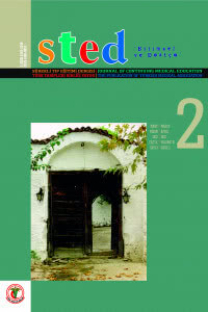Bir Üniversite Yerleşkesinin Açık Alanını Kullanan Kişilerin Güneşten Korunma Davranışları
Behaviors of Open Space Users to be Protected from Sun Exposure at the Health Campus of a University
___
- 1. https://sbu.saglik.gov.tr/Ekutuphane/kitaplar/ Sa%C4%9Fl%C4%B1%C4%9F%C4%B1n%20Te %C5%9Fviki%20S%C3%B6zl%C3%BCk.pdf. Erişim:5/7/2017
- 2. [Internet] http://www.who.int/healthpromotion/ conferences/previous/ottawa/en/. Erişim: 5/7/2017.
- 3. [Internet]https://sbu.saglik.gov.tr/Ekutuphane /kitaplar/Sa%C4%9Fl%C4%B1%C4%9F%C4%B 1n%20Te%C5%9Fviki%20S%C3%B6zl%C3%BC k.pdf. Erişim:5/7/2017.
- 4. Yurtseven E, Ulus T, Vehid S et al. Assessment of Knowledge, Behaviour and Sun Protection Practices among Health Services Vocational School StudentsInt. J. Environ. Res. Public Health 2012, 9(7), 2378-2385; [Internet] doi:10.3390/ijerph9072378 Erişim:17.07.17
- 5. Aynur, U.; Süheyla, A.O.; Safak, E. Evaluating the skin cancer risks and sun-protection practices of students. Ege Med. J. 2004, 43, 95-99[internet] http://www.oalib.com/references/8711448 Erişim:17.07.17
- 6. Grunfeld EA. What influences university students' intentions to practice safe sun exposure behaviours? J Adolesc Health 2004;35:486-92. [Internet] doi:10.1016/j.jadohealth.2003.11.093 Erişim:17.07.2017
- 7. Erkin G, Karaduman A. Güneş, güneşten korunma ve güneşten koruyucular[Internet]: http://www.tip.hacettepe.edu.tr/actamedica/2007 /sayi_2/baslik4.pdf Erişim:5/7/2017
- 8. Kaymak, Y.; Tekbaş, O.F.; Işıl, S. Knowledge, attitudes and behaviours of university students related to sun protection. Turk. Derm. 2007, 41, 81-85 [Internet] http://journal.turkderm.org.tr/eng/jvi.aspx?pdir=t urkderm&plng=eng&un=TURKDERM99608&look4= Erişim:17.07.17
- 9. Ferlay J, Shin HR, Bray F, Forman D, Mathers C, Parkin DM. Estimates of worldwide burden of cancer in 2008: GLOBOCAN 2008. Int J Cancer. 2010 Dec 15;127(12):2893- 917,
- 10. [Internet]: http://cevresagligi. thsk.saglik.gov.tr/bilgi-dokumanlar/halk-sagliginayonelik/988-a%C5%9F%C4%B1r%C4%B1- s%C4%B1caklarda-al%C4%B1nmas%C4%B1- gereken-%C3%B6nlemler.html Erişim:5/7/2017
- 11. [Internet]:http://webarchive.nationalarchives. gov.uk/+/http://www.dh.gov.uk/en/Publicationsa ndstatistics/Publications/PublicationsPolicyAndGuid ance/DH_4009609 Erişim: 19/07/2017
- 12. Ashish Magdum, Francesca Leonforte, Edwina McNaughton et al. Sun protection -Do we know enough? [Internet] http://www.sciencedirect.com/science/article/pii/S 1748681512000083 Erişim:19/07/17
- 13. Uslu M, Karaman G, Şavk E. Adnan Menderes Üniversitesi Hekimlerinin Deri Kanserleri Ve Güneşin Etkileri Konusundaki Bilgi Düzeyleri İle Güneşten Korunma Davranışlarının Değerlendirilmesi ADÜ Tıp Fakültesi Dergisi 2006 7(1) : 5 - 10 [Internet]:http://adudspace. adu.edu.tr:8080/xmlui/bitstream/handle/11607/2 008/5- 10.pdf?sequence Erişim: 25/07/2017
- 14. Yurtseven E, Ulus T, Vehid S et al. Assessment of Knowledge, Behaviour and Sun Protection Practices among Health Services Vocational School Students Int. J. Environ. Res. Public Health 2012, 9(7), 2378-2385;[Internet] doi:10.3390/ijerph9072378 Erişim:17/07/2017
- 15. [Internet]: https://www.thevisioncouncil.org/ content/uv-eye-protection/kids Erişim 25/07/2017
- 16. [Internet]: https://www.aao.org/eye-health/tipsprevention/summer-sun-eye-safety Erişim 25/07/2017
- 17. [Internet]:http://turkdermatoloji.org.tr/ media/files/file/GUNESTEN_KORUNMA.pdf Erişim 25/07/2017
- 18. Meyer N, Pruvost-Balland C, Bourdon-Lanoy E, Maubec E, Avri M.F. Awareness, knowledge and attitudes towards sun protection among skin cancer-treated patients in France. J. Eur. Acad. Dermatol. Venereol. 2007;21:520-525.
- 19. Yan S, Xu F. Demographic Differences in Sun Protection Beliefs and Behavior: A CommunityBased Study in Shanghai, China [Internet]:https://www.ncbi.nlm.nih.gov/pmc/articl es/PMC4377961/#!po=56.8750 Erişim: 25/07/2017
- 20. Sağlık Bakanlığı Yaşlı Sağlığı Modülleri, Şubat 2011 Ankara, [Internet]:https://sbu.saglik. gov.tr/Ekutuphane/kitaplar/yaslisagligi.pdf Erişim: 19/07/2017.
- ISSN: 1300-0853
- Yayın Aralığı: 6
- Başlangıç: 1992
- Yayıncı: -
Bir Üniversite Yerleşkesinin Açık Alanını Kullanan Kişilerin Güneşten Korunma Davranışları
Dilan KIZILIRMAK, Ebru DOĞAN, Fatma YÖRÜK, Fatma Zehra KIRŞAN, Hanife ÖZKAN, Merve TEKİNEMRE, TUĞBA MELİHA FATMA ERCAN
TTB Yüksek Onur Kurulu 2008-2010 ve 2010-2012 Dönemi Kararları Üzerinden Değerlendirme
FUNDA EVCİLİ, MİNE BEKAR, ZELİHA BURCU YURTSAL, Gülçin ABAK, Berrin TALİ, Sultan TEMEL
Üniversite Öğrencilerinin Flört Şiddetine İlişkin Tutum ve Davranışları
GÜLNAZ KARATAY, MAHMUT KARATAY, Nazan Gürarslan BAŞ, Kazım BAŞ
Sağlık Profesyoneli Olan ve Olmayan Hastane Çalışanlarının Sağlıklı Yaşam Biçimi Davranışları*
Handan ÇETİNER, SEVİM ULUPINAR
Evrensel Etik İlkeler Işığında Açlık Grevleri ve Hekimlik
Onur Naci KARAHANCI, ÖRNEK Nüket BÜKEN
Kadınların Doğum Yöntemleri ve Sezaryen Sonrası Vajinal Doğum Hakkında Düşünceleri
Elif Saime GÜLER, EMRE YANIKKEREM
MELDA KANGALGİL, Ayşe Nur ACAR, HÜLYA YARDIMCI
Üniversite Öğrencilerinin Erken Yaş Evlilikler Hakkında Bilgi ve Görüşlerinin İncelenmesi
OYA KAVLAK, Şenay Ünsal ATAN, ÖZNUR YAŞAR, Nilüfer YANIK TOK
